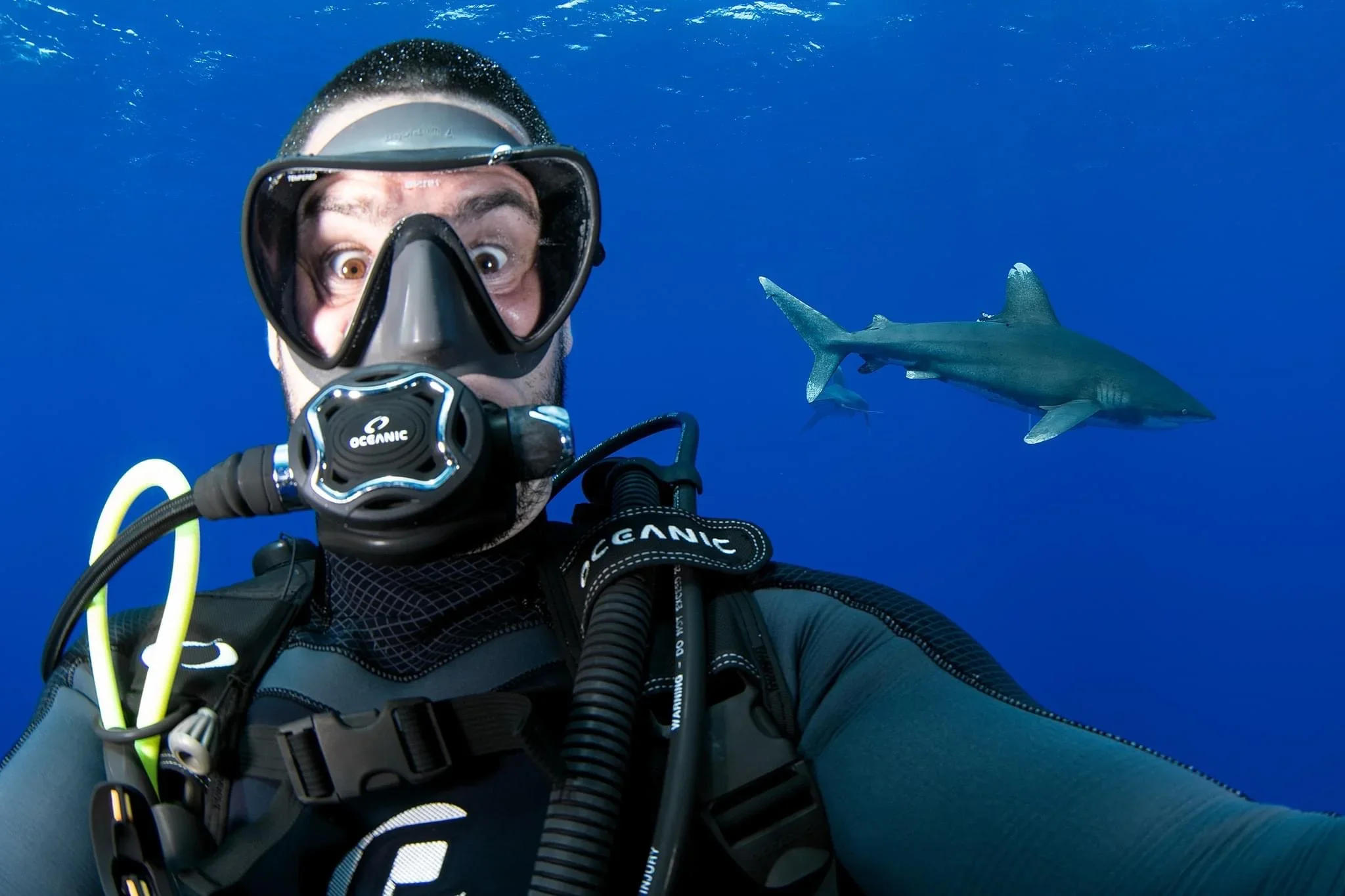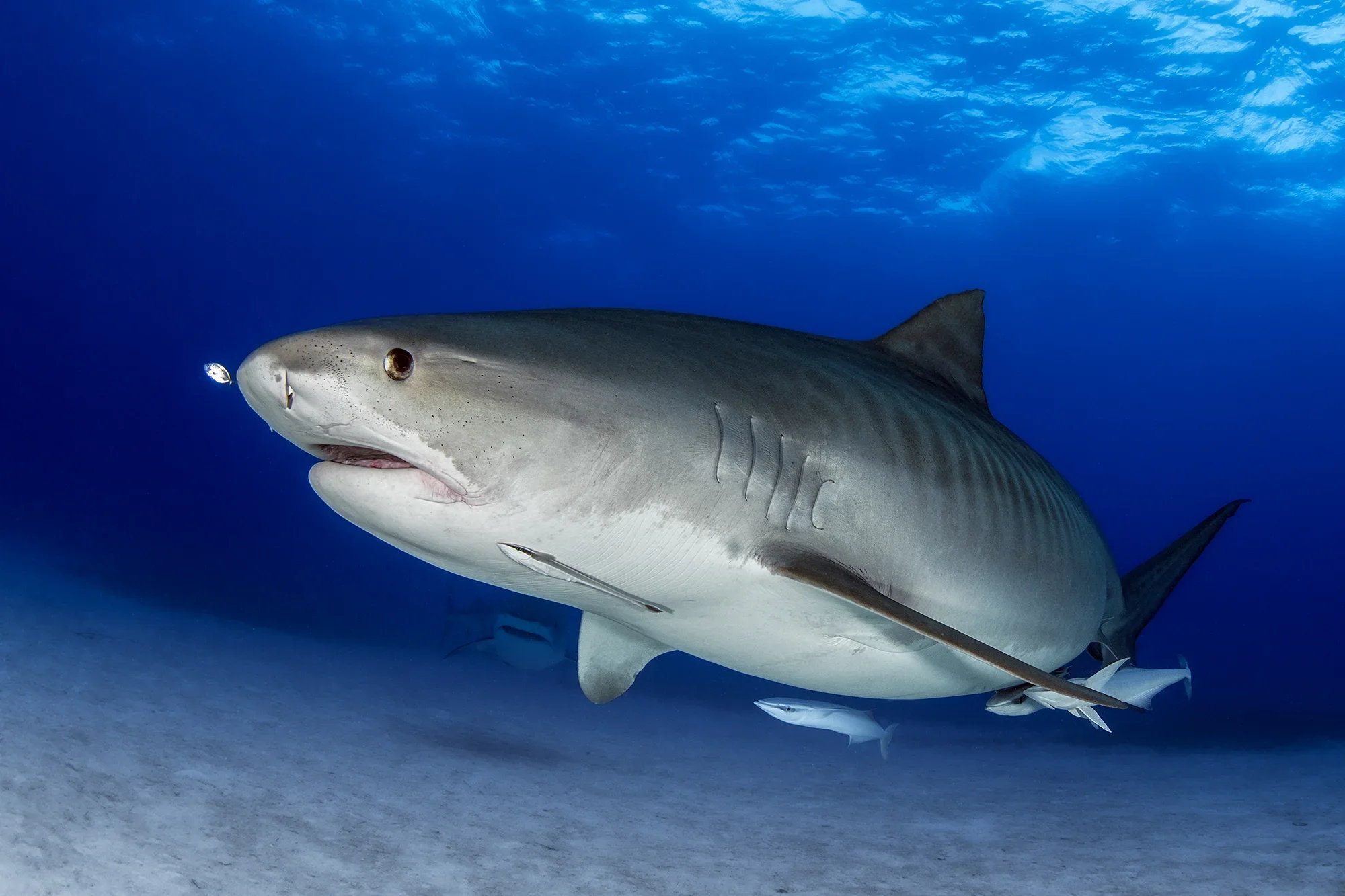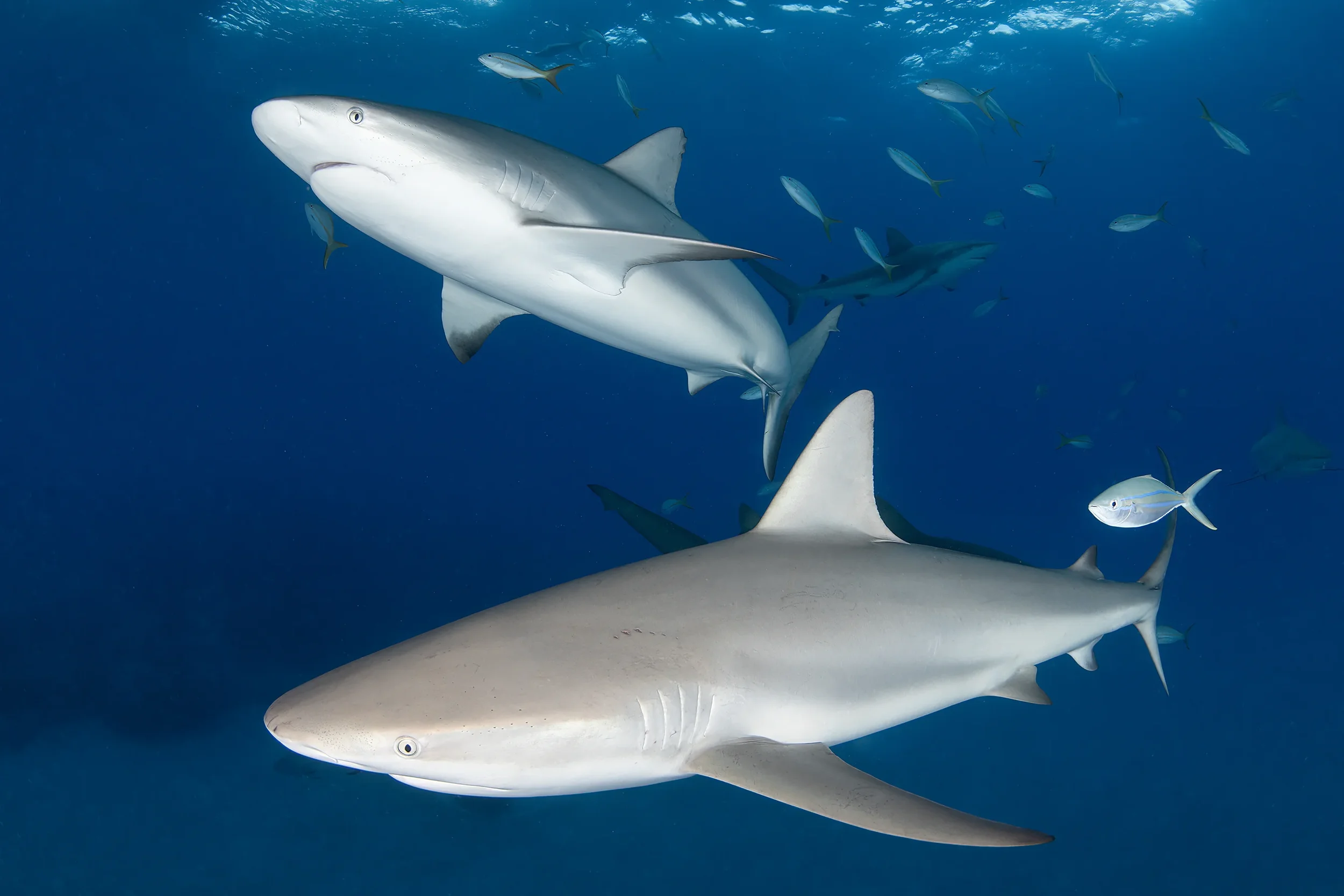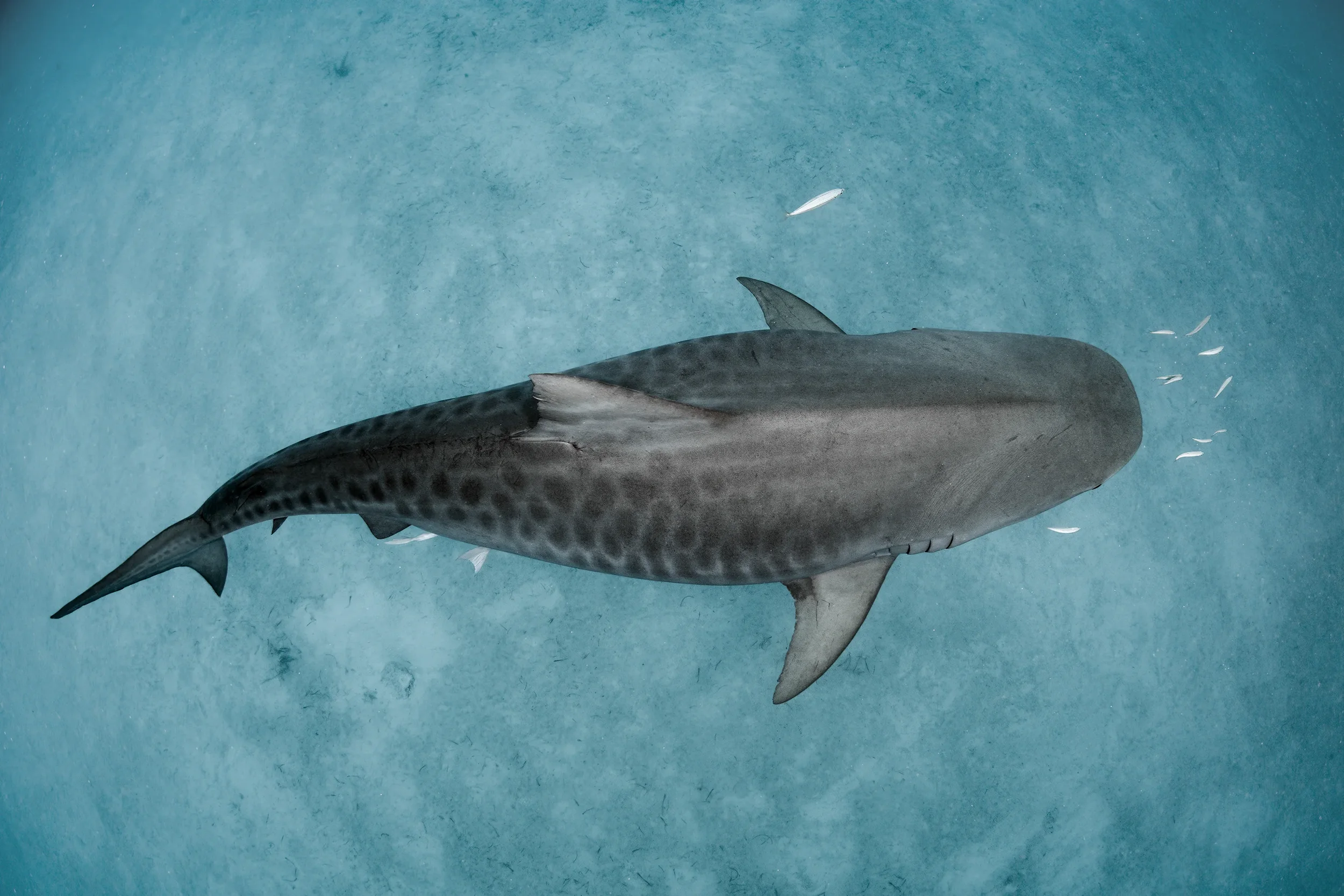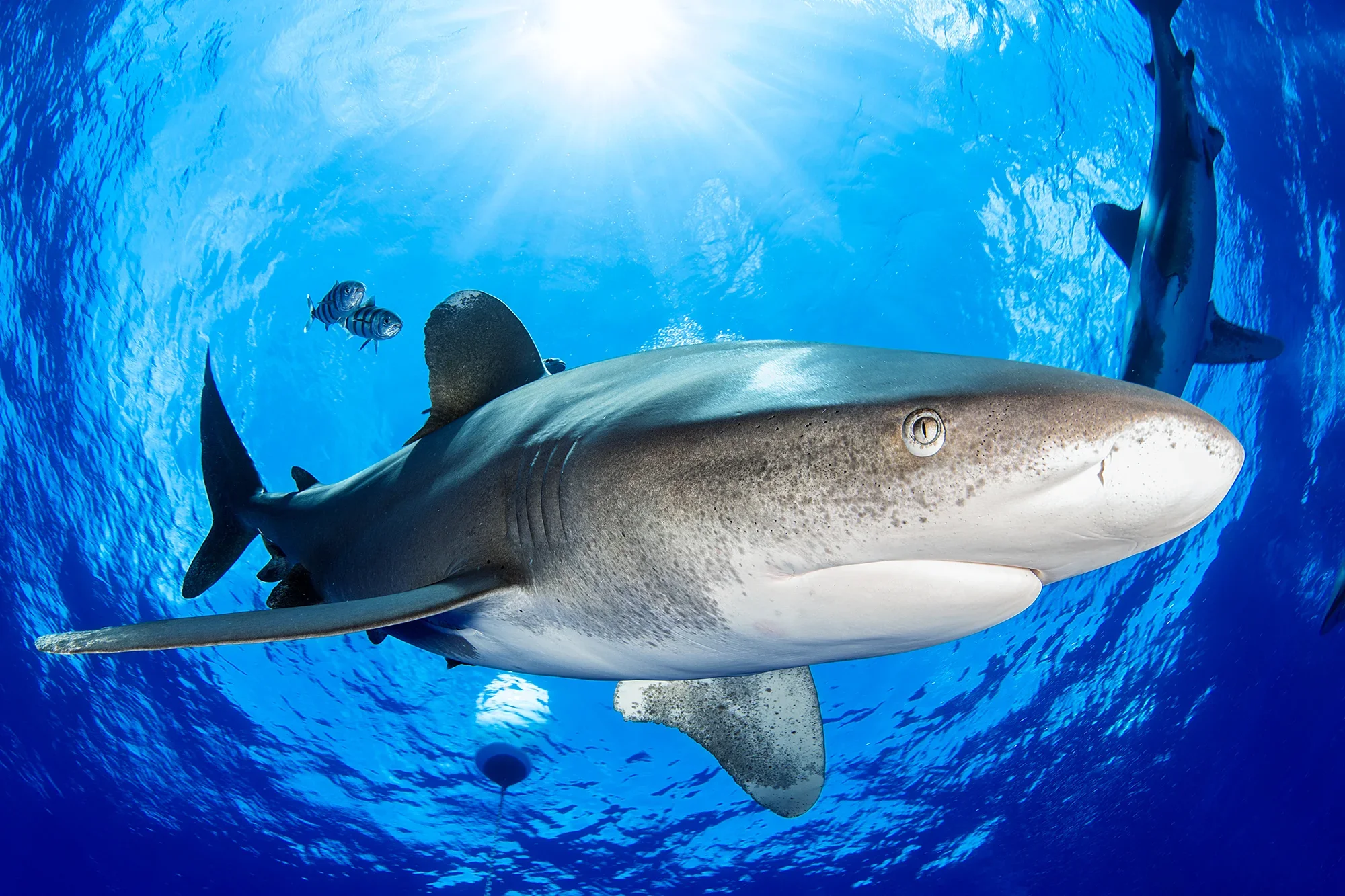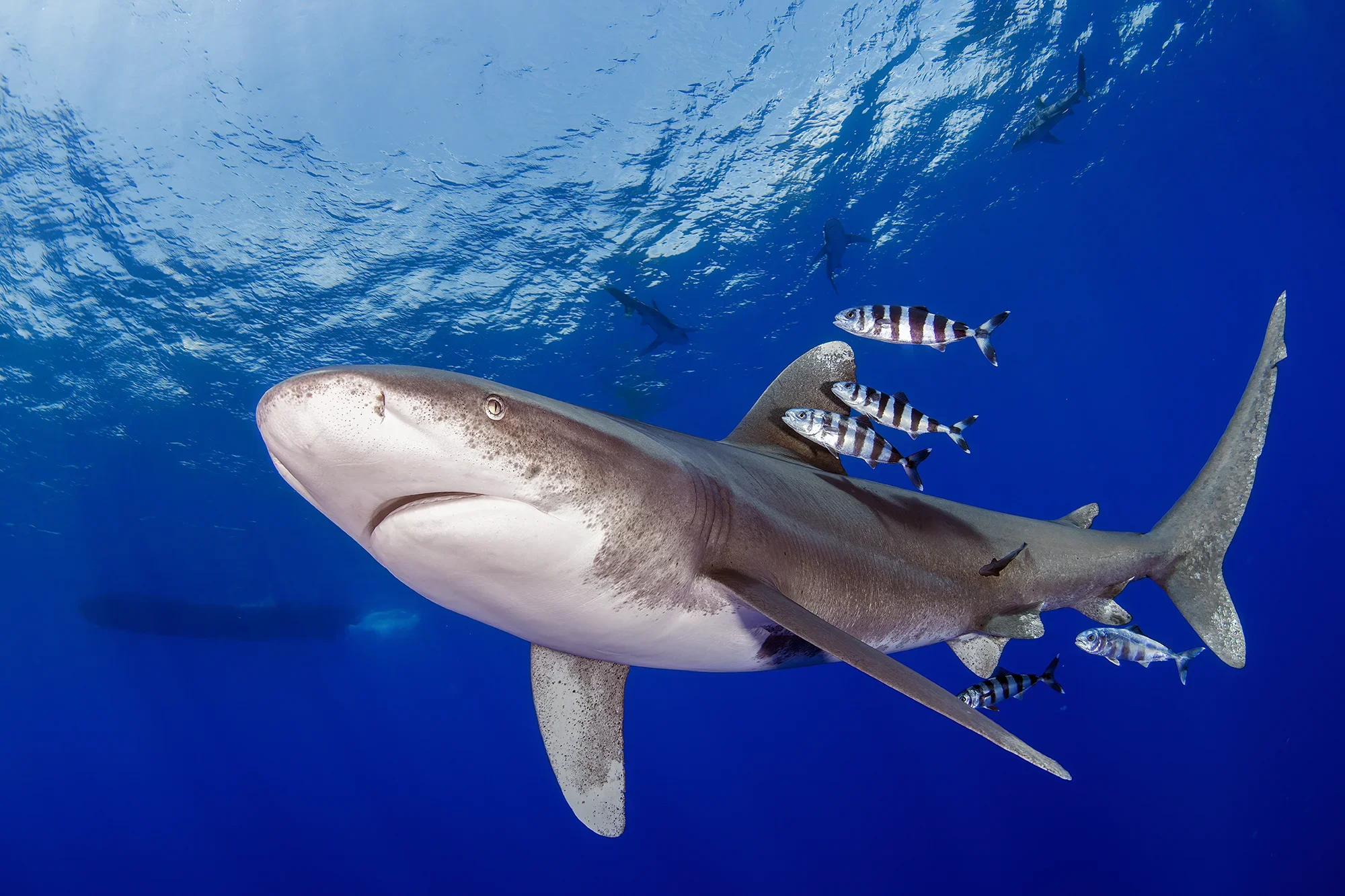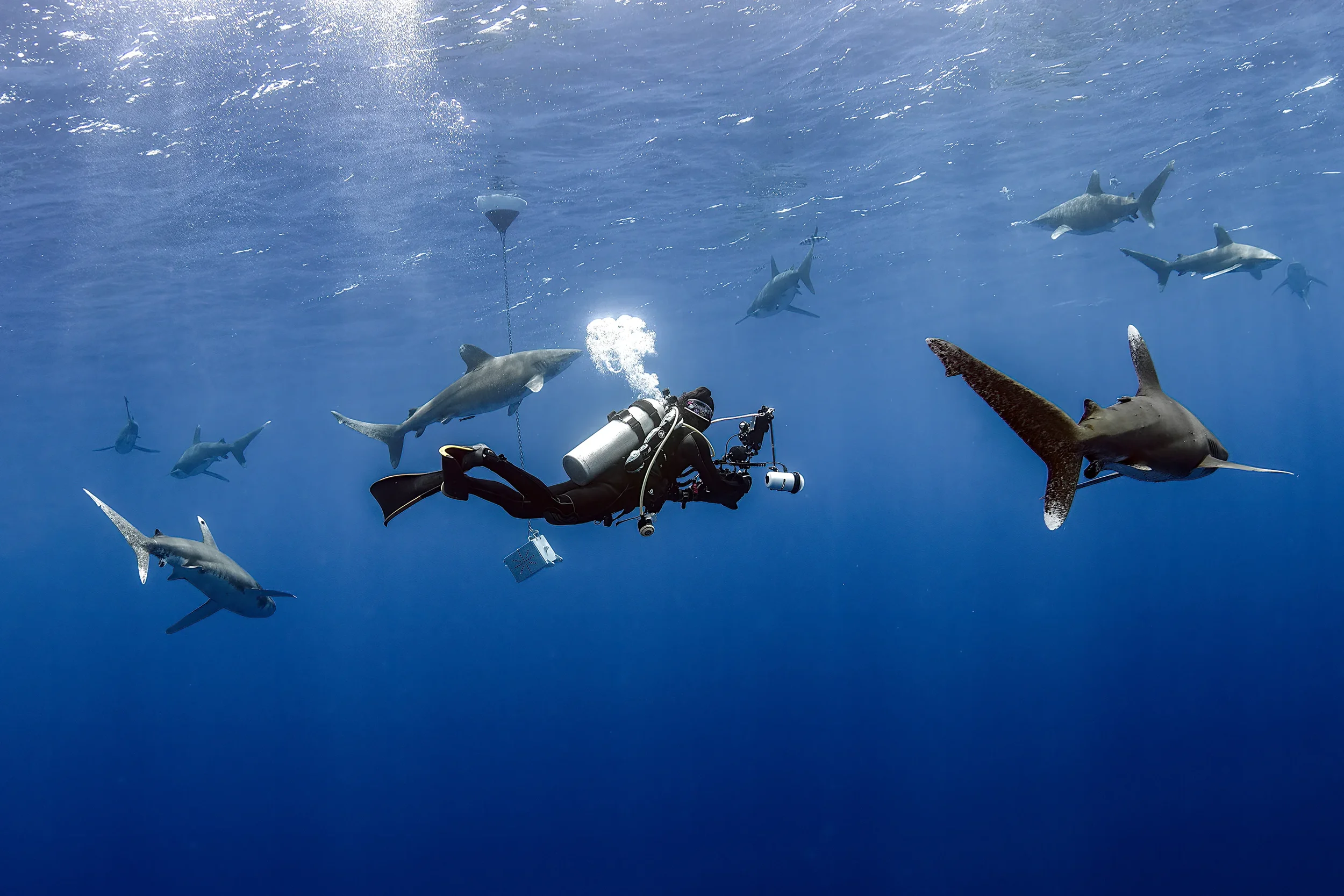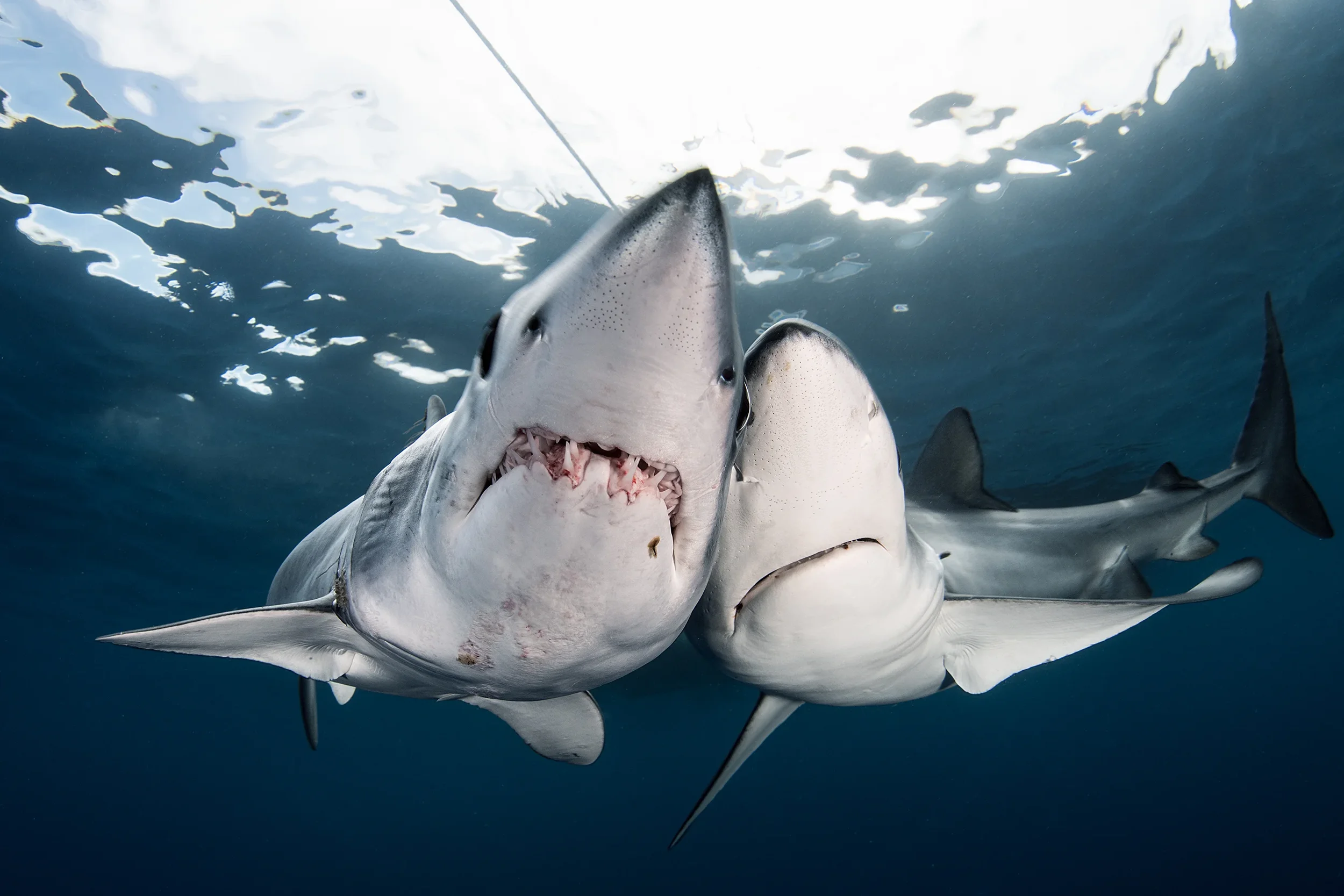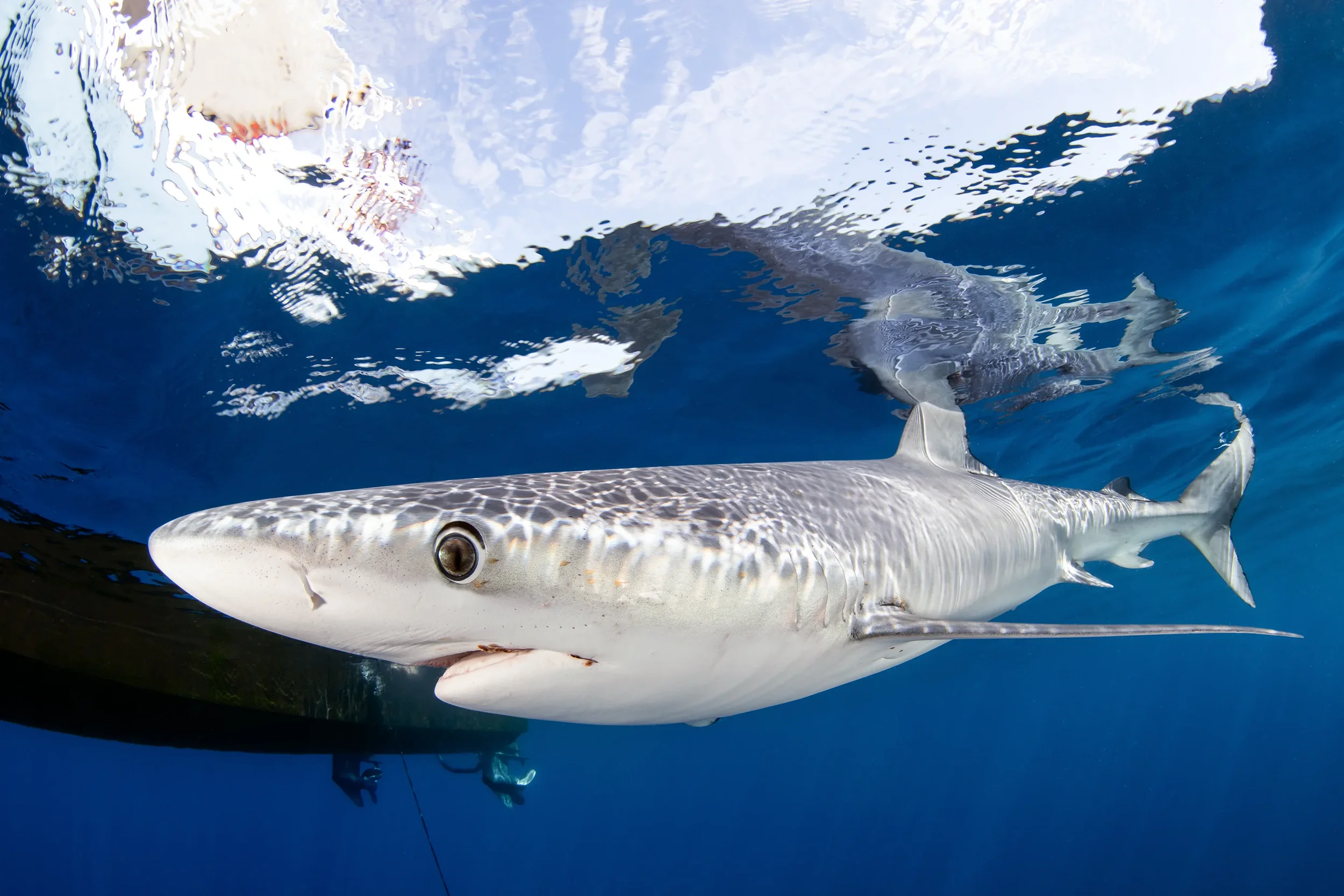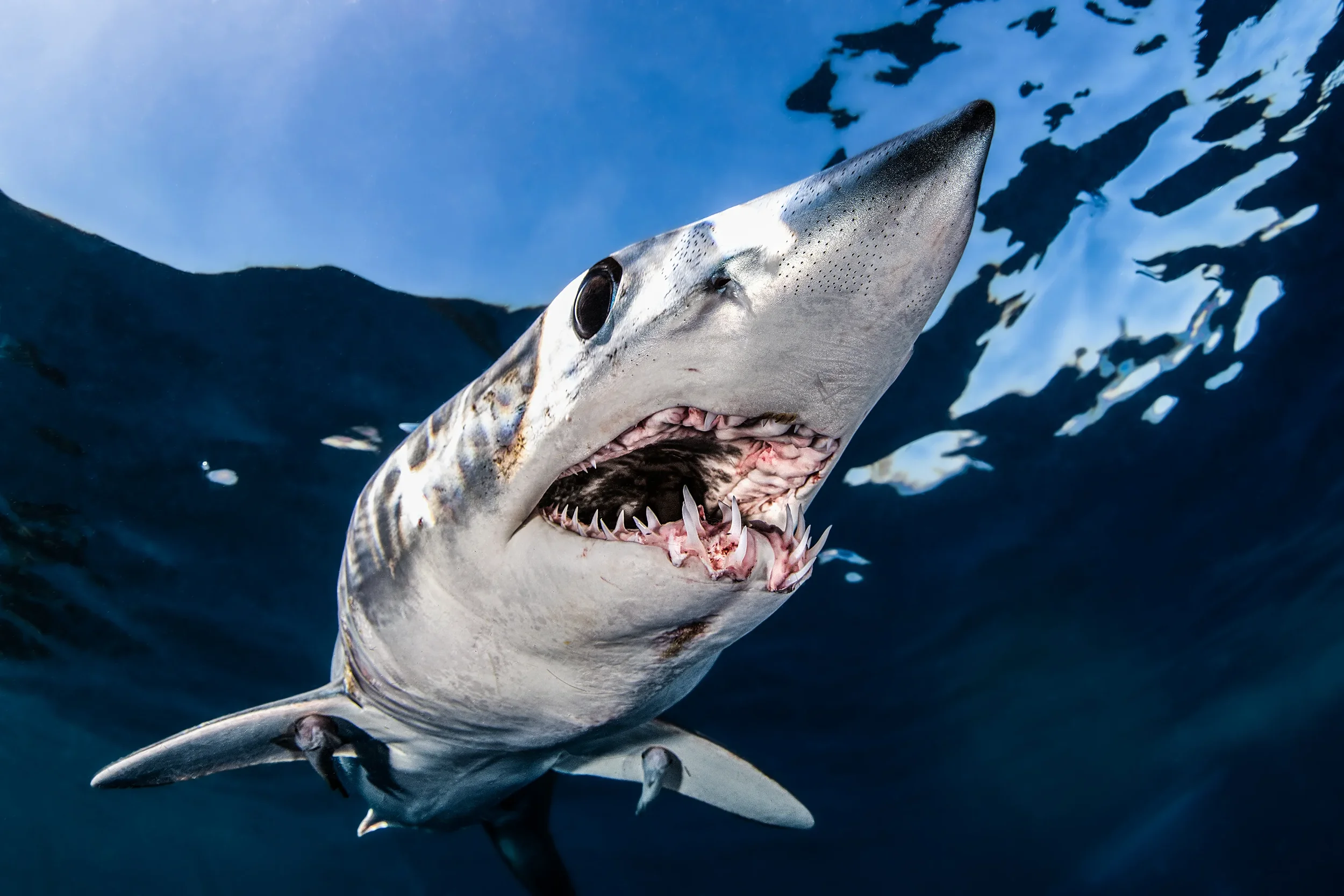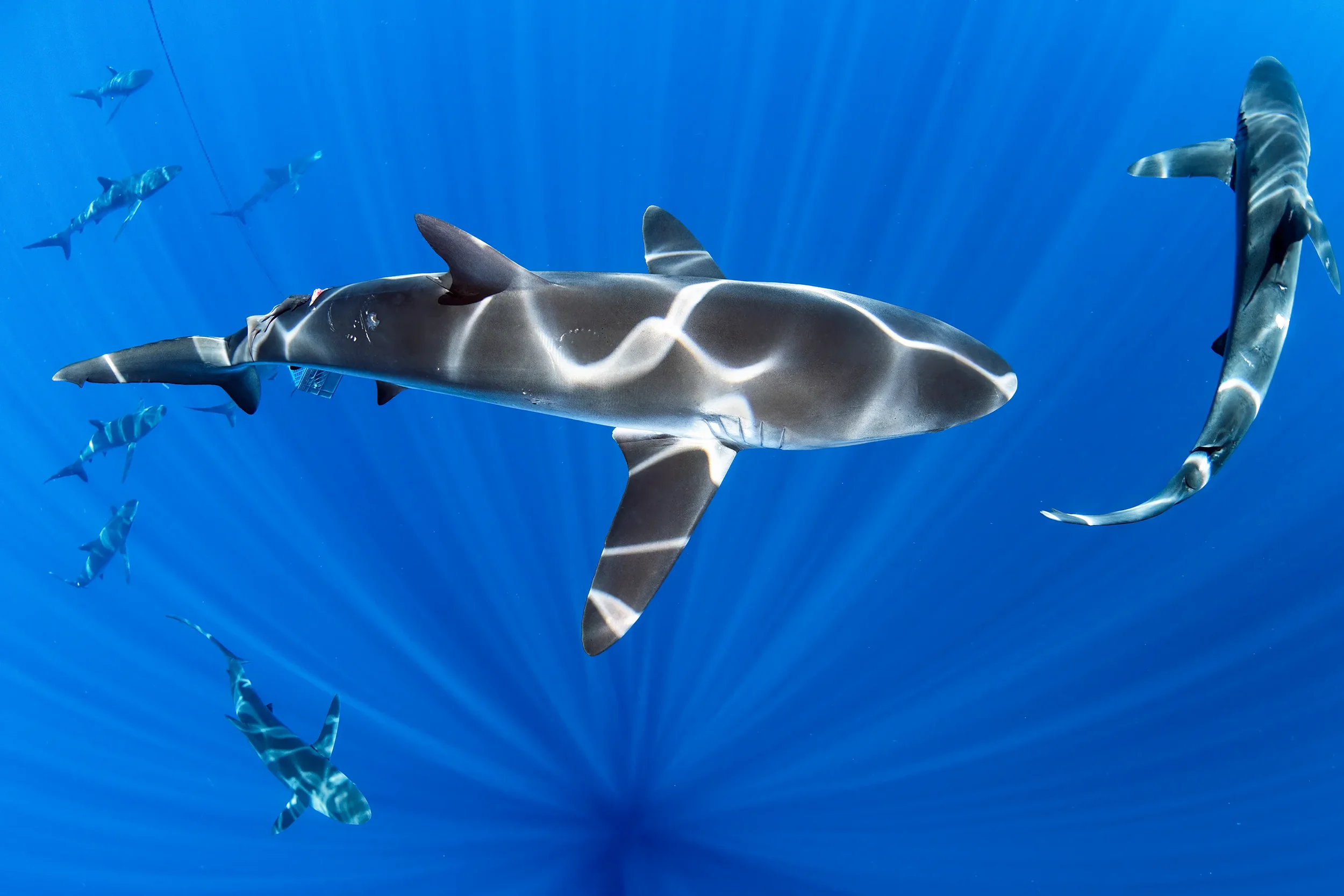Ultimate Shark Diving Bucket List: Part 1
Over the years, I’ve been fortunate to dive in some very sharky locations—ranging from deep-water drifts with dozens of pelagic species to shallow, sandy banks with giant species like tiger sharks. As much as I love all big animal encounters, sharks hold a special place in my heart, and I cherish any chance to reminisce about the amazing times I’ve had photographing a wide variety of species in stunning locations around the globe.
With this in mind, I thought it would be fun to start a blog series highlighting my favorite shark diving hotspots. In this article, we take a closer look at two incredible Bahamian sites—home to tiger sharks and oceanic whitetips, respectively—before heading offshore from Cabo San Lucas to explore the energetic interactions between blue sharks and the shortfin mako!
TIGER BEACH
If you love sharks (tiger sharks in particular), this site needs little introduction. Located off West End in the Bahamas, Tiger Beach is by far the best location in the world to see and photograph tiger sharks—alongside many other tropical species. As an exposed location on a shallow sandbank, strong winds can create difficult conditions, but when the ocean is calm and the sun is shining, this place is a shark-lover’s dream come true.
So many sharks, every dive!
Tiger Beach is a very sharky dive, and you’re all but guaranteed to see multiple species every single dive.
Tiger sharks are, of course, the main event. The tigers at Tiger Beach are enormous—ranging anywhere from 3 to 5 metres in length, with a girth that can be genuinely shocking the first few times you experience it up close. While these sharks are typically slow movers, they can be very sneaky, often approaching from your blind spots as they investigate. It’s important to keep your head on a swivel and help keep your buddies alerted to the sneaky ones, as they can be tricky to track—especially when there are 7+ sharks in the area!
Once you’ve had your fill of tiger sharks, you can focus on photographing the “smaller” species: lemon sharks and Caribbean reef sharks. The lemon sharks at Tiger Beach are extremely photogenic, often swimming just off the back of the dive deck—making them perfect subjects for split photography. The Caribbean reef sharks, on the other hand, can become a bit of a nuisance, often getting in the way while trying to compose shots of the much more impressive tigers—but don’t forget to show them some love too!
Other species include tawny nurse sharks, which spend most of their time around any bait crates, and even great hammerheads and bull sharks are known to make an appearance from time to time. Unfortunately, I’ve yet to be that lucky myself.
What makes it so special?
Here are three main reasons why this is my favourite dive site to photograph tiger sharks, among the other species mentioned above:
Freedom!
I’ve dived many tiger shark sites around the world, including some in the Maldives and Fiji—both of which were quite restrictive when it comes to photography. While I can’t speak for all operators, the Dolphin Dream liveaboard strikes the perfect balance between maximising safety while allowing photographers the freedom needed to capture quality images.Shallow water
Tiger Beach has an average depth of about 8 to 12 metres. This offers a huge advantage for photographers looking to maximise light to produce sharp, vibrant images. It also allows for not only longer dives, but more frequent dives each day without ever approaching your decompression limit. Expect to log some serious hours underwater on a week-long liveaboard!The scenery
The underwater environment is breathtaking. A clean, sandy bottom coupled with crystal-clear blue water makes for spectacular imagery. During my last visit, my dive buddies and I joked that it’s almost impossible to take a bad image here—it really is that beautiful. The only catch is finding a way to make your images stand out from the countless other photographers who visit each year!
When to visit?
If your goal is to maximise encounters and photographic opportunities, it’s best to visit Tiger Beach between October and June. While sharks are likely to be present in large numbers year-round, targeting these months will guarantee fantastic diving.
CAT ISLAND
Remaining in The Bahamas, the next location is lesser dived—largely due to the fact that not many people are keen to dive with what inhabits these local waters: the oceanic white tip shark.
Cat Island, in the far south of The Bahamas, is the best destination in the world to experience this infamous predator up close and personal. While other hot spots exist—like the Red Sea, Hawaii, and French Polynesia—none compare to the sheer number of white tips you’ll find here.
The Perfect Subject
Oceanic whitetip sharks are a beautiful species, with long, rounded fins extending from a stocky, powerful build. Their iconic, speckled white-tipped fins make them unmistakable in the water, and they possess a curiosity and boldness that typically results in very close encounters. In short: they are an absolute dream to photograph.
Be Prepared
As mentioned above, Cat Island is known for an abundance of white tips during the peak months of March to May. If you’re planning to visit, it’s important to know what you’re signing up for! When I visited in April 2023, we averaged anywhere from 10 to 15 oceanic white tips per dive. By day three, we broke the (then-current) record with an insane 23 individuals in the water at once.
It’s crucial to remain calm, stay aware of your surroundings, and of course, follow the direction of experienced local guides.
When to visit?
If your goal is to maximise white tip numbers, March to May is the best time of year to dive Cat Island. This conveniently coincides with peak season at Tiger Beach—making it the perfect encore after a week of tiger sharks!
CABO SAN LUCAS
If you’ve followed me on socials for any amount of time, you’ll know how much I love Baja California Sur in Mexico. One of the main reasons? The incredible pelagic shark action that takes place off the coast of Cabo San Lucas during the cooler months.
The two star species here are the short fin mako shark and the blue shark—both pelagic predators known for their inquisitive natures, though in very different ways.
The Blue Shark
Blue sharks are, quite simply, adorable. Their big, round eyes, gigantic overbites and slender builds can easily lull divers into a false sense of security. But it’s important to remember: they are incredible predators. Like the white tips of Cat Island, they’re often sneaky—approaching from blind spots.
That said, they make for amazing photo subjects. During peak season, it’s not uncommon to have 6–7 blue sharks circling you at the surface.
The Short fin Mako Shark
Declaring an “all-time favourite shark species” is something I try to avoid—purely because it tends to change—but if I had to choose, it would likely be the short fin mako.
My first dive with makos was in 2020, when a local guide described them as “mini great whites on cocaine.” Looking back, it’s hard to disagree.
Built like missiles, these sharks arrive at speed, darting between divers in the water. They’re extremely photogenic, offering thrilling imagery—and if you manage to spark one’s curiosity just right, you might capture the coveted bite shot (though often at the expense of your dome port!).
Other Species
In my opinion, the blues and makos are the most exciting sharks to photograph in Cabo. However, two other species—silky sharks and smooth hammerheads—also show up, particularly during the summer months. Just up the coast from Cabo, in San José del Cabo, silky sharks can be seen in huge aggregations, sometimes exceeding 50 individuals.
Patience is Key!
Shark action off the coast of Cabo relies on chumming—mixing discarded fishing scraps with salt water to create a bloody, oily slick dumped off the back of the boat while drifting in open water.
As the boat drifts, the slick sinks into the deep blue. Blue sharks and makos typically reside in this zone and, with time, will follow the trail up to the surface. While it can take an hour or two (sometimes longer), once the sharks arrive, they often hang around—offering countless photographic opportunities.
Final Thoughts
So there you have it—my three favourite shark hot spots so far. Whether you’re into tiger sharks, oceanic white tips, or high-speed pelagic encounters, these destinations offer world-class diving and unforgettable encounters.
If you enjoyed the read, feel free to share this post on your socials and keep an eye out for my next three favourite shark dives!

